Violence Prevention
On December 14 th , 2012 gunfire rang out at Sandy Hook Elementary School in Newton, Connecticut. On that day, a 20-year-old individual took the lives of 20 children within 5 minutes. This shooting tragically became the second deadliest mass school shooting at that time; following the 2007 mass shooting at Virginia Tech University, where 32 students lost their lives. Prior to the 2000’s, Columbine also shattered hearts and headlines across the nation in 2019, when two high school students killed 12 of their own classmates, and then themselves.
Over the decades, violence against youth, and amongst youth is growing at an astronomical rate. As a result of the immeasurable loss at Sandy Hook Elementary School, National Youth Violence Prevention Week was developed. Now, each year at the end of April, a multitude of organizations place a great emphasis on how to prevent youth violence within families, communities, and schools. The commitment is intended to look at how youth violence has evolved; how such violence can be targeted; and what preventative measures can be implemented with the intent of reducing such horrific attempts and acts of violence upon and amongst youth.
In order to better understand youth violence, research has found 3 major factors that most commonly lead others to commit acts of violence, and specifically target youth populations. Those three major factors include a history of, or current exposure to, domestic violence, child abuse, and media influence. Five interesting facts about youth violence are also:
- Homicides committed by youth are up 65% from 315 in 2016 to 521 in 2022. Researchers speculate that an increase of firearm access for youth; residual effects from the Covid-19 pandemic and isolation; and the uptick of threats being made on social media, are contributing factors as well.
- Violence against and amongst youth does not discriminate by age, socioeconomic status, or geographic location. Roughly 1,150,000 high school students face an incident with a weapon at a school.
- In four out of five school shootings, at least one other person was aware an attack was about to happen, but most do not say anything before the event unfortunately takes place.
- The number of crimes committed by children under 18 involving firearms and the number of people seriously injured in such crimes has increased by more than 20% since 2020.
- In Illinois, an average of 183 children and teens die by guns every year, and 82% of these deaths are homicides.
With all of that being said, the question becomes what can we do about youth violence, and how does Family Service Association of Greater Elgin contribute to Youth Violence Prevention Week? Here at FSA, we are committed to serving youth and families through a wide array of services, groups, therapies, and in a variety of settings. Our team of professionals is dedicated to identifying risk factors; addressing adverse childhood experiences; and being accessible and present in local school-based and community settings/events.
In addition, FSA is also currently partnering with Kane County Health Department to bring attention and awareness to Mental Health First Aid, Firearm Restraining Orders, and Firearm Safe Storage. Broadly, the goal of Firearm Restraining Orders and safe gun storage is to reduce or prevent suicide by firearms, and other gun related violence from taking place. Within Illinois there are two types of Firearm Restraining Orders, each of which can be filed for at a local Circuit Clerks Office. FSA and the Health Department currently provide outside agencies and individuals training on Firearm Restraining Orders, which take about an hour and can be hosted at your organization, or virtually. In addition, FSA is also providing free cable locks to individuals within the community who hold a valid FOID card; and the Kane County Health Department has biometric gun safes to provide to valid FOID card holders as well. The goal of Safe Gun Storage is to reduce the ease and access youth and vulnerable individuals have to firearms, when impulsive behavior can lead to quick, and deadly results. To inquire about a Mental Health First Aid Training, Firearm Restraining Order Training, or a safe gun storage device, please contact Ashley Kellenberger, Violence Prevention Coordinator at FSA, at akellenberger@fsaelgin.org.
As David Muhammad, Executive Director of the National Institute for Criminal Justice Reform, has famously stated, “People who commit acts or attempts are often identifiable, the violence is predictable, and therefore it is preventable.” FSA is proud to stand in support with National Youth Violence Prevention week; support youth and families in our community; and provide trainings and promote awareness to reduce gun violence and tragic loss towards and amongst youth.


